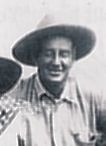View entry
Name: RATTRAY, Andrew 'Jock' (Capt.)

Nee: 5th son of John Rattray, Broom of Dalreoch
Birth Date: 1876 Dunning, Perthshire
Death Date: 13.11.1933 Nairobi
First Date: 1913
Last Date: 1933
Profession: Animal catcher
Area: Isiolo
Married: In Nairobi 29 Jan 1932 Averill Furness b. 22 July 1908 Hartlepool, d. 6 Jan 1936 Nairobi (dau. of Viscount Furness)
Book Reference: Lytton, Cobbold, Alexander, Red 25, Red 31, Hut, Barnes, Sutton, Nicholls, Medals, Chandler
War Service: Scottish Horse, late Thorneycroft's Mounted Infantry in Boer War
General Information:
Lytton - Isiolo - Rattray for a drink - tough bush ranger - catching Grevy zebra for zoos. He had fought a leopard with his bare hands and escaped although with badly bitten wrists. Married the daughter of a noble lord but it is said it did not turn out well and they both died long before their time. Here was a man!
Cobbold - Unfortunately Mr Rattray died last year, leaving his wife, Lord Furness's daughter, a widow after a very short married life, and the zebras have all been scattered and sold.
Alexander - Rattray - lived at Isiolo and helped the Martin Johnsons with their packing and loading. It is said that Rattray had strangled a leopard with his bare hands, and Osa [Johnson] had virtually saved his life by bathing his badly mauled arms for over a week in a saline solution, helping him to recover completely - an unlikely thing in those days of no antibiotics. Rattray also made something of a name for himself in Nairobi by driving little carts around the town with Grevy Zebras between the shafts. An old friend of mine [Alexander], Chris Elliot said he had a terrible job in the mornings getting them into the shafts ready for the day's 'taxi service'!
Nairobi Forest Road cemetery - Andrew Rattray, British, age 52, died 13/11/33
Sutton - 1924 - While we were having tea, Andrew Rattray, the famous "zebra man" called. Rattray owns a big ranch near Iseola and it was on his land that Mr and Mrs Martin Johnson got their wonderful zebra pictures and also shot their big lion. Rattray is a handsome young Scotchman who has spent most of his life in South and East Africa. Several years ago he began capturing and training Grevy zebras, and as he is the only perrson who has ever succeeded in doing this, he soon attained a world-wide reputation. He is a quiet, unassuming chap and one of the most popular men in Kenya Colony.
Nicholls - dashing Pete Rattray, who captured the heart of the daughter of Lord Furness on one safari. She married him. A man of squarish build and firm expression, Rattray had a farm seven miles up the Isiolo river where he tried to break Grevy zebra to harness. He managed to get some to pull ploughs.
Medals - East Africa Veterinary Corps - Andrew Rattray, No. 5058, Private
Chandler - Jock Rattray was a professional hunter based at Isiolo in the 1920s and working for the firm of Safariland Ltd. Rattray was at the centre of one of the many scandals that were constantly cropping up in the hunting business. Viscount Furness, like many of his class, enjoyed an annual big-game hunting safari in East Africa. Furness always brought along his wife and his teenage daughter, a tomboy named Averill, and always engaged Jock Rattray as his white hunter. The expeditions lasted 6 weeks and were cheerful, successful affairs, at least until 1934. That year a deep affection grew between Rattray and young Averill, and the two lovers ran off and eloped.
Furness originally vowed to shoot Rattray on sight but then settled for disinheriting his daughter and placing an advertisement in the 'East African Standard' that Rattray was no longer his professional hunter. Rattray had a team of Grevy zebras that he trained to pull a buggy; he owned a farm and frequently caught wild animals and sold them to American zoos. He was badly injured by a wounded leopard in the early 1920s.
Web DNW - Captain Andrew Rattray was the fifth son of John Rattray, Broom of Dalreoch, Dunning, Perthshire. He enlisted into Thorneycroft’s Mounted Infantry in 1899, and served in South Africa with Thorneycroft’s Mounted Infantry 1899-1900, with the Commander-in-Chief’s Bodyguard 1900-01, and with the 1st Scottish Horse 1901-02. He took part in the Relief of Ladysmith, including action at Colenso (wounded); operations of 17-24 January 1900, including action at Spion Kop; operations of 5-7 February 1900, including action at Vaal Krantz; operations on the Tugela Heights and action at Pieter’s Hill. Took part in the operations in Natal, March to June 1900, including action at Laing’s Nek, and in subsequent operations in the Transvaal. He was promoted Sergeant in Thorneycroft’s Mounted Infantry in 1900, was discharged and enlisted into the C.-in-C.’s Bodyguard in October 1900, being promoted Sergeant-Major. After discharge he enlisted in the 1st Scottish Horse, was appointed Lieutenant in 1901, and was present at the actions at Moedwil and Rooiwal, being promoted Captain and mentioned in despatches. Andrew Rattray was one of 9 brothers, two of whom served with him in the Scottish Horse during the Boer War. He resigned his commission after the war, thereafter spending some time in the Argentine, and finally settled in Kenya, where he became a renowned hunter. On his farm outside Nairobi, he domesticated zebra, which he sent all over the world to zoos; he also fought a leopard to death with his bare hands. With one hand he clutched the leopard's throat, and the other he thrust into the beast's mouth in an effort to suffocate him. This he managed to do but he was severely mauled in the process. His devoted native servants carried him over 200 miles to Nairobi, where he received lengthy, but successful, medical treatment.
Andrew became the white hunter to Lord Furness, shipping magnate and colliery owner. The Viscount's young daughter, the Hon Averill Furness, fell in love with the 50 year-old hunter, and they were secretly married. Lord Furness was furious and disinherited her. The couple lived together in the bush until Andrew suddenly became ill and died. He was 51 - his wife was 24. The story goes that Averill secluded herself alone in the bush and drank herself to an early death. The incident is recorded by Gloria Vanderbilt in her book 'Double Exposure'.
Time Magazine 1932 - Monday, Feb. 15, 1932 - Foreign News: Fiery Furness Lions are occasionally seen on the Nairobi, British East Africa golf course. There is also a cinema theatre, but apart from these diversions life in Nairobi can be excessively dull. The Hon. Averill Furness, 23-year-old daughter of Viscount Furness, shipbuilding tycoon, and Andrew Rattray, her father's 50-year-old professional hunter, found it so one evening last month as they finished dinner. Next morning, with a maid and a typist as the only witnesses, they were secretly married. Lord Furness was out in the bush hunting lions. To break the news to her father, Mrs. Rattray dispatched an airplane to his safari. Last week Lord Furness's wrathful roar resounded through the veldt. The romance of Hunter Rattray and the Hon. Averill began in London last year when he arrived with two live zebras that Lord Furness wanted.* But Lord Furness was too busy with large affairs to notice a surreptitious courtship.
When news of Hon. Averill's elopement reached Lord Furness by plane he loudly swore that he would disown any daughter of his who married a zebra trainer. Back flew the plane to Nairobi with a notice which last week appeared in the East African Standard: "To Whom it May Concern: Mr. A. Rattray has ceased to be the hunter to my safari and from this date has no authority to order anything to my account. (Signed) FURNESS."
Lady Furness, who before her marriage was an American, the well-known Mrs. Thelma Morgan Converse of New York, had no such harsh feelings about her step daughter's marriage. In London last week she took issue with her fiery husband, cabled congratulations to Zebraist Rattray & bride. *In Nairobi grey-haired convivial Hunter Rattray is best known for his work in domesticating zebras. The Tanganyika government gave him an experimental farm, where he has succeeded in breaking the larger and more modestly patterned Grevy's zebra to harness. The work is of great interest to African settlers for, though zebras lack the stamina of horses, asses, or mules, they are immune to the deadly tsetse fly.
Red 25 - Trader, Isiolo, Meru
Johnson - I Married Adventure - Mr. Rattray, a man of squarish build and firm expression and perhaps fifty years of age, turned out to be one of those people who do strange things in the out-of-the-way places of the world. His hobby was breaking Grevy zebra to harness. They were immune to the tetse fly, he said, and the feeding problem was simple, because they could live on the dry, sparse vegetation of the plains. The sight of them pulling a plow seemed to fascinate Father Johnson.
